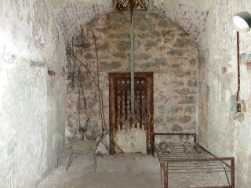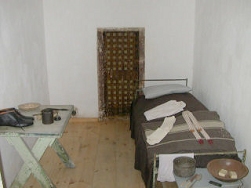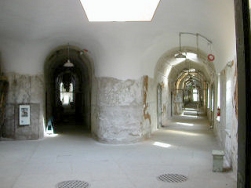Eastern State Penitentiary
2027 Fairmount Avenue
Philadelphia, PA 19130
(215) 236-3300 Information • (215)
564-6377 Office
www.easternstate.org
| Places Nearby: | |||||
| Philadelphia Museum of Art , Rodin Museum (see Philadelphia Museum of Art) | |||||
| Franklin Institute Science Museum | |||||
| Please Touch Museum | |||||
| Moore Art Galleries | |||||
|
Eastern State Penitentiary is beginning to reclaim some of the fame it enjoyed during the 19th century, when it was hailed the world over as the ideal design for a prison. The massive structure was copied some 300 times in South America, Northern Europe, Russia, China, Japan, and across the British Empire. Today's fame, though, is a result of the institution's emerging status as one of Philadelphia's premier museums.
 Seen from above, the complex resembles a wheel with its spokes meeting at a hub, the spokes being cell blocks. Designed by architect John Haviland and opened in 1829, Eastern State was surrounded by concrete walls 30 feet high and 12 feet thick at the base. The cost was $780,000 -- the most expensive building in America at the time. Today it is a National Historic Landmark.
Seen from above, the complex resembles a wheel with its spokes meeting at a hub, the spokes being cell blocks. Designed by architect John Haviland and opened in 1829, Eastern State was surrounded by concrete walls 30 feet high and 12 feet thick at the base. The cost was $780,000 -- the most expensive building in America at the time. Today it is a National Historic Landmark.
Inherent in the word penitentiary are two concepts: punishment and reformation. The idea was revolutionary, befitting a new nation, as it was a break from the brutality of the past. Loss of freedom would replace physical pain as punishment. This machine for reform was called the Pennsylvania System.
 Each prisoner was to have his or her own private cell. Adjacent to the cell a private outside exercise yard, contained by a ten-foot wall, ensured that prisoners would have only the light from heaven, the word of God (the Bible), and honest work as a road to penitence. The honest work might include shoemaking, weaving, or the like.
Each prisoner was to have his or her own private cell. Adjacent to the cell a private outside exercise yard, contained by a ten-foot wall, ensured that prisoners would have only the light from heaven, the word of God (the Bible), and honest work as a road to penitence. The honest work might include shoemaking, weaving, or the like.
The concept had its proponents and opponents, the most famous detractor being Charles Dickens who said, "I hold this slow and daily tampering with the mysteries of the brain to be immeasurably worse than any torture of the body."
As for this writer, if I had my druthers, I believe I'd choose the solitary cell and courtyard. Eventually the detractors won out. In the early 20th century the Pennsylvania System was abandoned. Eastern State operated until 1971 as a congregate prison, where inmates shared common areas.
The Penitentiary has a very interesting history. Willie Sutton and Al Capone did time here. And Pep the dog was sentenced to life here by Governor Gifford Pinchot for murdering his wife's cat (I'm just the messenger). Mug shots of these and other inmates are among the photographic exhibits that can be seen behind these walls.
 The tour is a relatively new opportunity, having been available for just a few years. Tours are Self-Guided, and a Guided Tour is a free option. Beginning with an orientation in the inmates' visitor room, participants can view the cell blocks, central rotunda, the yard past the prison greenhouse, and death row. The tour is quite extensive. It is also fascinating and educational. Visitors learn about the various attempted prison breaks and the lives of the more colorful inmates.
The tour is a relatively new opportunity, having been available for just a few years. Tours are Self-Guided, and a Guided Tour is a free option. Beginning with an orientation in the inmates' visitor room, participants can view the cell blocks, central rotunda, the yard past the prison greenhouse, and death row. The tour is quite extensive. It is also fascinating and educational. Visitors learn about the various attempted prison breaks and the lives of the more colorful inmates.
Groups are welcome, School Groups will probably find a Guided Tour to be one of the most exciting field trips they've had. Note: Children must be at least 7 years old. A note if you take a winter tour: it's cold in there, so bundle up!
| Hours: Open 10am - 5pm (last entry at 4pm) every day, twelve months a year, except closed on Thanksgiving, Christmas Eve, Christmas Day, and New Year's Day. During the winter tours are available by reservation only. During the summer reservations are not required for individuals and families. However, call for the regular tour schedule as well as info on special tours, or visit Eastern State's website, linked above. Tickets can also be purchased online. | ||
Admission:
|
||
Groups (15 or more people):
|
||
| Group Reservations: At least 1 week in advance. | ||
| Lunch: Nearby restaurants. Tour/Dining packages available. | ||
| Handicapped Access: Accessible. | ||
| Directions: Located on Fairmount Ave. at 22nd St. | ||
Copyright © 1996-2008 by Patrick Tadeushuk. All Rights Reserved.
